Study on Catastrophic Evolution Law of Water and Mud Inrush in Water-Rich Fault Fracture Zone of Deep Buried Tunnel
Abstract
:1. Introduction
2. Tunnel Engineering Geology
3. Study of Physical Model Test on Water and Mud Inrush in Parallel Fault
3.1. The Development of Fluid–Solid Coupling of Similar Materials
3.2. The Process of Physical Model Testing
3.3. The Analysis of Experimental Results
3.3.1. The Stress Variation of Surrounding Rock
3.3.2. The Impact of Water Pressure Loading on the Evolutionary Law of Water and Mud Inrush
4. Simulation Scheme and Calculation Model Establishment
4.1. Numerical Simulation Scheme Design
4.2. Establishment of Computational Model
5. Analysis of Evolution Law of Water and Mud Inrush in Fault Fracture Zone
5.1. Analysis of Displacement Field Evolution Law
5.2. Analysis of Stress Field Evolution Law
5.3. Analysis of Evolution Law of Pore Water Pressure
5.4. Analysis of Seepage Velocity Law
6. Conclusions
- (1)
- Taking the Dazhushan Tunnel as the research background, a self-developed 3D physical model test system and similar materials were used to carry out physical model testing of water and mud inrush in a parallel fault. The evolution process of water inrush and mud inrush disasters in weak surrounding rocks was reproduced. Multiple pieces of information, such as the rock stress at different positions of the tunnel during excavation and water pressure loading stages, pore water pressure between the anti-rock mass and the fault interior, and images of the evolution process of water and mud inrush, were obtained. Among these, the optimal ratio of similar materials for the surrounding rock required for physical model testing is sand:red clay:cement:water = 80.27%:6.35%:4.68%:8.70%, and the optimal ratio of similar materials for filling faults is red clay:sand:gravel = 42%:42%:16%.
- (2)
- During the physical model test, as the tunnel is excavated, radial stress in the surrounding rock at the arch gradually decreases owing to stress releasing, while the vertical stress at the left and right walls gradually increases. Closer to the excavation contour line, the changes are more significant. During water pressure loading, pore water pressure at each measuring point increases with higher loading. Additionally, at the same loading conditions, pore water pressure decreases as the vertical distance from each point to the fault’s upper boundary increases. By non-linear fitting, the experimental values of the relative water pressure coefficient of monitoring points under various loading water pressures, and the exponential function relationship between the relative water pressure coefficient of any point in the outburst-prevention rock mass of the monitoring section and its vertical distance from the fault’s upper boundary, were obtained.
- (3)
- For the numerical simulation of the parallel fault excavation in the tunnel, the maximum vertical displacement is observed at the arch’s top and bottom, while the maximum horizontal displacement happens at the left and right walls. Excavation affects the vertical displacement of the arch vault more than the arch ring, while it has a greater impact on the horizontal displacement of the arch ring compared to the arch vault. The maximum principal stress value is mainly concentrated near the upper left and lower right corners of the arch wall and fault. The maximum and minimum principal stresses of the arch top unit will first increase, then decrease, and then increase again. The trend of the maximum and minimum principal stresses of the right arch ring unit is significantly different. The changes in the pore water pressure field are significant when the tunnel is excavated to 10 m and 50 m, showing a U-shaped distribution and a funnel-shaped distribution, respectively. The pore water pressure at each monitoring point decreases with the increase in excavation distance; the seepage flow velocity of each monitoring point shows a trend of first increasing and then decreasing, and the right arch, which is closer to the vertical distance from the fault, is most prone to water inrush. The results can provide relevant references for the prevention of water and mud inrush disasters due to other fault types in the future.
Author Contributions
Funding
Data Availability Statement
Conflicts of Interest
References
- Li, S.C.; Xu, Z.H.; Huang, X.; Lin, P.; Zhao, X.C.; Zhang, Q.S.; Yang, L.; Zhang, X.; Sun, H.F.; Pan, D.D. Classification, geological identification, hazard mode and typical case studies of haz-ard-causing structures for water and mud inrush in tunnels. Chin. J. Rock Mech. Eng. 2018, 37, 1041–1069. [Google Scholar]
- Gao, M.; Xie, J.; Guo, J.; Lu, Y.; He, Z.; Li, C. Fractal evolution and connectivity characteristics of mining-induced crack networks in coal masses at different depths. Geomech. Geophys. Geo-Energy Geo-Resour. 2021, 7, 9. [Google Scholar] [CrossRef]
- Zhu, C.; Karakus, M.; He, M.; Meng, Q.; Shang, J.; Wang, Y.; Yin, Q. Volumetric deformation and damage evolution of Tibet interbedded skarn under multistage constant-amplitude-cyclic loading. Int. J. Rock Mech. Min. Sci. 2022, 152, 105066. [Google Scholar] [CrossRef]
- Hu, L.; Wang, J.; Karrech, A.; Li, X.; Zhao, P.; Liu, L. Exploring the frontiers of deep underground sciences and engineering—China Yun-long Lake Laboratory is striving to be the best. Deep. Undergr. Sci. Eng. 2022, 1, 131–137. [Google Scholar] [CrossRef]
- Sousa, R.L.; Einstein, H.H. Lessons from accidents during tunnel construction. Tunn. Undergr. Space Technol. 2021, 113, 103916. [Google Scholar] [CrossRef]
- He, M.; Sui, Q.; Tao, Z. Excavation compensation theory and supplementary technology system for large deformation disasters. Deep. Undergr. Sci. Eng. 2023, 2, 105–128. [Google Scholar] [CrossRef]
- Dou, Z.; Tang, S.; Zhang, X.; Liu, R.; Zhuang, C.; Wang, J.; Zhou, Z. Influence of shear displacement on fluid flow and solute transport in a 3D rough fracture. Lithosphere 2021, 2021, 1569736. [Google Scholar] [CrossRef]
- Tan, Y.; Lu, Y.; Wang, D. Catastrophic Failure of Shanghai metro line 4 in July, 2003: Occurrence, emergency response, and disaster relief. J. Perform. Constr. Facil. 2021, 35, 04020125. [Google Scholar] [CrossRef]
- Tan, Y.; Lu, Y.; Wang, D. Catastrophic failure of Shanghai Metro Line 4 in July 2003: Postaccident Rehabilitation. J. Perform. Constr. Facil. 2023, 37, 04023006. [Google Scholar] [CrossRef]
- Ma, D.; Rezania, M.; Yu, H.-S.; Bai, H.-B. Variations of hydraulic properties of granular sandstones during water inrush: Effect of small particle migration. Eng. Geol. 2017, 217, 61–70. [Google Scholar] [CrossRef]
- Zhang, L.W.; Wu, J.; Zhang, X.Y. Mechanism of water inrush from the tunnel face induced by fault and its application. J. Cent. South Univ. 2023, 30, 934–946. [Google Scholar] [CrossRef]
- Li, Z.H.; Feng, G.R.; Zhai, C.Z. Study on “triangle” water-inrush mode of strong water-guide collapse column. J. Cent. South Univ. 2016, 23, 2402–2409. [Google Scholar] [CrossRef]
- Tang, R.; Li, S.Q.; Wang, J.; Xiang, L.; Xie, W. Research on Mechanism and Treatment Technology of Water lnrush and Mud lnrush in Tunnel of Water-rich Fault Zone. Chin. J. Undergr. Space Eng. 2021, 17, 1264–1272+1290. [Google Scholar]
- Liu, J.; Chen, W.; Liu, T.; Yu, J.; Dong, J.; Nie, W. Effects of Initial Porosity and Water Pressure on Seepage-Erosion Properties of Water Inrush in Completely Weathered Granite. Geofluids 2018, 11, 4103645. [Google Scholar]
- Huang, Z.; Li, X.Z.; Li, S.J.; Zhao, K.; Xu, H.W.; Wu, R. Research and development of similar material for liquid-solid coupling and its application in tunnel water-inrush model test. J. Cent. South Univ. (Sci. Technol.) 2018, 49, 3029–3039. [Google Scholar]
- Huang, Z.; Li, S.J.; Zhao, K.; Wu, Y.; Wu, Z. Liquid-solid Coupling Model Test to Investigate Seepage Failure Mechanism of Intact Con-fining Rocks of Tunnels. J. Basic Sci. Eng. 2019, 27, 1345–1356. [Google Scholar]
- Wang, K.; Li, S.C.; Zhang, Q.S.; Zhang, X.; Li, L.P.; Zhang, Q.Q.; Liu, C. Development and application of new similar materials of surrounding rock for a flu-id-solid coupling model test. Rock Soil Mech. 2016, 37, 2521–2533. [Google Scholar]
- Guo, Y.; Kong, Z.; He, J.; Yan, M. Development and Application of the 3D Model Test System for Water and Mud Inrush of Water-Rich Fault Fracture Zone in Deep Tunnels. Math. Probl. Eng. 2021, 16, 8549094. [Google Scholar] [CrossRef]
- Hu, D.; Li, Y.; Yang, X.; Liang, X.; Zhang, K.; Liang, X. Experiment and Application of NATM Tunnel Deformation Monitoring Based on 3D Laser Scanning. Struct. Control Health Monit. 2023, 2023, 3341788. [Google Scholar] [CrossRef]
- Liu, H.; Yue, Y.; Lian, Y.; Meng, X.; Du, Y.; Cui, J. Reverse-time migration of GPR data for imaging cavities behind a reinforced shield tunnel. Tunn. Undergr. Space Technol. 2024, 146, 105649. [Google Scholar] [CrossRef]
- Yin, H.; Wu, Q.; Yin, S.; Dong, S.; Dai, Z.; Soltanian, M.R. Predicting mine water inrush accidents based on water level anomalies of borehole groups using long short-term memory and isolation forest. J. Hydrol. 2023, 616, 128813. [Google Scholar] [CrossRef]
- Hu, D.; Hu, Y.; Yi, S.; Liang, X.; Li, Y.; Yang, X. Surface Settlement Prediction of Rectangular Pipe-Jacking Tunnel Based on the Machine-Learning Algorithm. J. Pipeline Syst. Eng. Pract. 2023, 15, 04023061. [Google Scholar] [CrossRef]
- Zhang, X.; Zhu, H.; Jiang, X.; Broere, W. Distributed fiber optic sensors for tunnel monitoring: A state-of-the-art review. J. Rock Mech. Geotech. Eng. 2024, in press. [CrossRef]
- Zhang, X.H.; Broere, W. Design of a distributed optical fiber sensor system for measuring immersed tunnel joint deformations. Tunn. Undergr. Space Technol. 2023, 131, 104770. [Google Scholar] [CrossRef]
- Golian, M.; Teshnizi, E.S.; Nakhaei, M. Prediction of water inflow to mechanized tunnels during tunnel-boring-machine advance using numerical simulation. Hydrogeol. J. 2018, 26, 2827–2851. [Google Scholar] [CrossRef]
- Moon, J.; Fernandez, G. Effect of excavation-induced groundwater level drawdown on tunnel inflow in a jointed rock mass. Eng. Geol. 2010, 110, 33–42. [Google Scholar] [CrossRef]
- Bahrami, S.; Ardejani, F.D.; Aslani, S.; Baafi, E. Numerical modelling of the groundwater inflow to an advancing open pit mine: Kolahdarvazeh pit, Central Iran. Environ. Monit. Assess. 2014, 186, 8573–8585. [Google Scholar] [CrossRef]
- He, H.; Wang, S.; Shen, W.; Zhang, W. The influence of pipe-jacking tunneling on the deformation of existing tunnels in soft soils and the effectiveness of protection measures. Transp. Geotech. 2023, 42, 101061. [Google Scholar] [CrossRef]
- Cai, M.; Kaiser, P.; Morioka, H.; Minami, M.; Maejima, T.; Tasaka, Y.; Kurose, H. FLAC/PFC coupled numerical simulation of AE in large-scale underground excavations. Int. J. Rock Mech. Min. Sci. 2007, 44, 550–564. [Google Scholar] [CrossRef]
- Jiang, A.; Zheng, S.; Wang, S. Stress-seepage-damage coupling modelling method for tunnel in rich water region. Eng. Comput. 2019, 37, 2659–2683. [Google Scholar] [CrossRef]
- Sweetenham, M.G.; Maxwell, R.M.; Santi, P.M. Assessing the timing and magnitude of precipitation-induced seepage into tunnels bored through fractured rock. Tunn. Undergr. Space Technol. 2017, 65, 62–75. [Google Scholar] [CrossRef]
- Farhadian, H.; Katibeh, H.; Huggenberger, P.; Butscher, C. Optimum model extent for numerical simulation of tunnel inflow in fractured rock. Tunn. Undergr. Space Technol. 2016, 60, 21–29. [Google Scholar] [CrossRef]
- Zhang, X.; Sanderson, D.J.; Barker, A.J. Numerical study of fluid flow of deforming fractured rocks using dual permeability model. Geophys. J. Int. 2002, 151, 452–468. [Google Scholar] [CrossRef]
- Zhao, K.; Janutolo, M.; Barla, G.; Chen, G. 3D simulation of TBM excavation in brittle rock associated with fault zones: The Brenner Exploratory Tunnel case. Eng. Geol. 2014, 181, 93–111. [Google Scholar] [CrossRef]
- Wang, M.; Feng, Y.T.; Owen DR, J.; Qu, T.M. A novel algorithm of immersed moving boundary scheme for fluid–particle interactions in DEM–LBM. Comput. Methods Appl. Mech. Eng. 2019, 346, 109–125. [Google Scholar] [CrossRef]
- Ma, D.; Li, Q.; Cai, K.-C.; Zhang, J.-X.; Li, Z.-H.; Hou, W.-T.; Sun, Q.; Li, M.; Du, F. Understanding water inrush hazard of weak geological structure in deep mine engineering: A seepage-induced erosion model considering tortuosity. J. Central South Univ. 2023, 30, 517–529. [Google Scholar] [CrossRef]
- Wu, P.; Fang, Z.; Wang, X.; Zhu, G. Reliability evaluation and prediction of deep buried tunnel based on similarity theory and model test. KSCE J. Civ. Eng. 2023, 27, 2654–2665. [Google Scholar] [CrossRef]
- Li, Z.; Lv, S.; Zhao, J.; Liu, L.; Hu, K. Research on the experimental system of reinforcing the base of shallow buried and wet collapsible loess tunnels. Buildings 2023, 13, 1740. [Google Scholar] [CrossRef]
- Zheng, Q.; Zhang, X.; Shen, Y.S.; Qiu, J.T.; Wang, Y.D.; Chen, K.F. Failure mechanism of segmental lining structure in fault-crossing tunnel: An experimental and numerical investigation. J. Cent. South Univ. 2023, 30, 2392–2410. [Google Scholar] [CrossRef]
- Chen, D.; Wang, L.; Versaillot, P.D.; Sun, C. Triaxial creep damage characteristics of sandstone under high crustal stress and its constitutive model for engineering application. Deep. Undergr. Sci. Eng. 2023, 2, 262–273. [Google Scholar] [CrossRef]
- Jiang, X.; Zhang, X.; Zhang, X.; Long, L.; Bai, Y.; Huang, B. Advancing Shallow Tunnel Construction in Soft Ground: The Pipe-Umbrella Box Jacking Method. Transp. Res. Rec. J. Transp. Res. Board 2024, 1–19. [Google Scholar] [CrossRef]
- Zhang, X.H.; Chen, J.; Bai, Y.; Chen, A.; Huang, D.Z. Ground surface deformation induced by quasi-rectangle EPB shield tunneling. J. Zhejiang Univ. (Eng. Sci.) 2018, 52, 317–324. [Google Scholar] [CrossRef]
- Han, X.; Ye, F.; Han, X.; Ren, C.; Song, J.; Zhao, R. Mechanical responses of underground carriageway structures due to construction of metro tunnels beneath the existing structure: A case study. Deep. Undergr. Sci. Eng. 2024, 3, 231–246. [Google Scholar] [CrossRef]
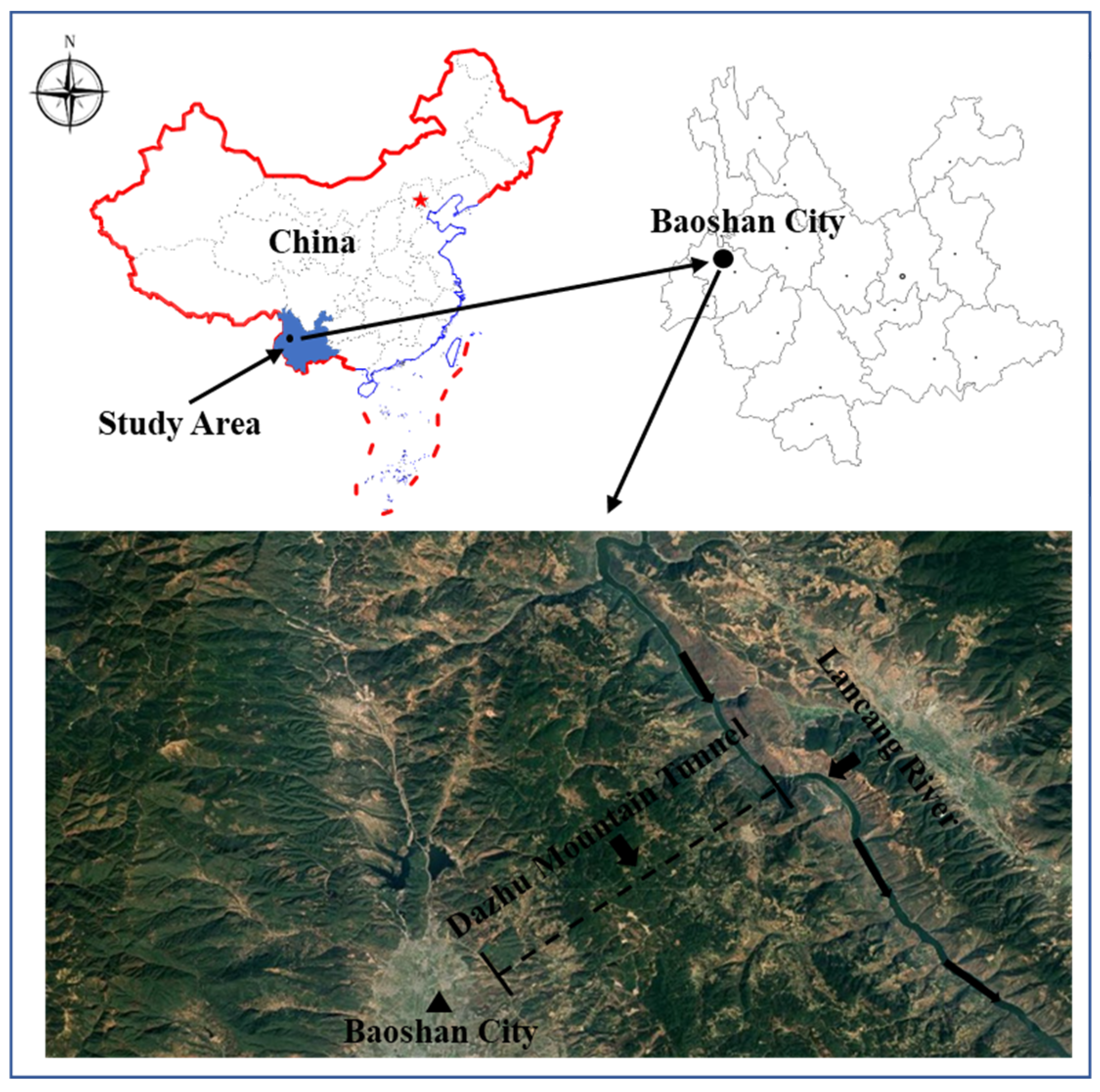
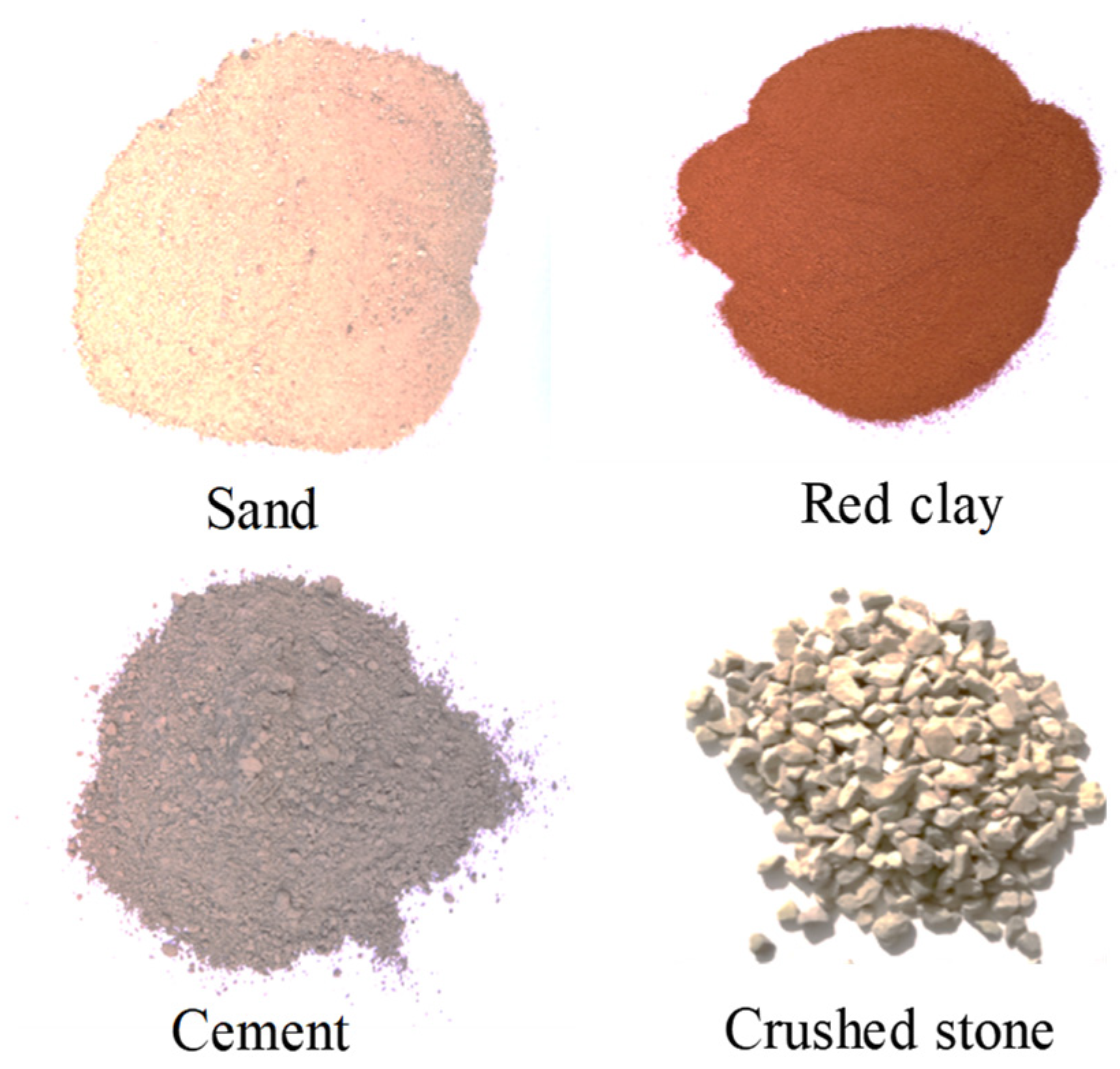
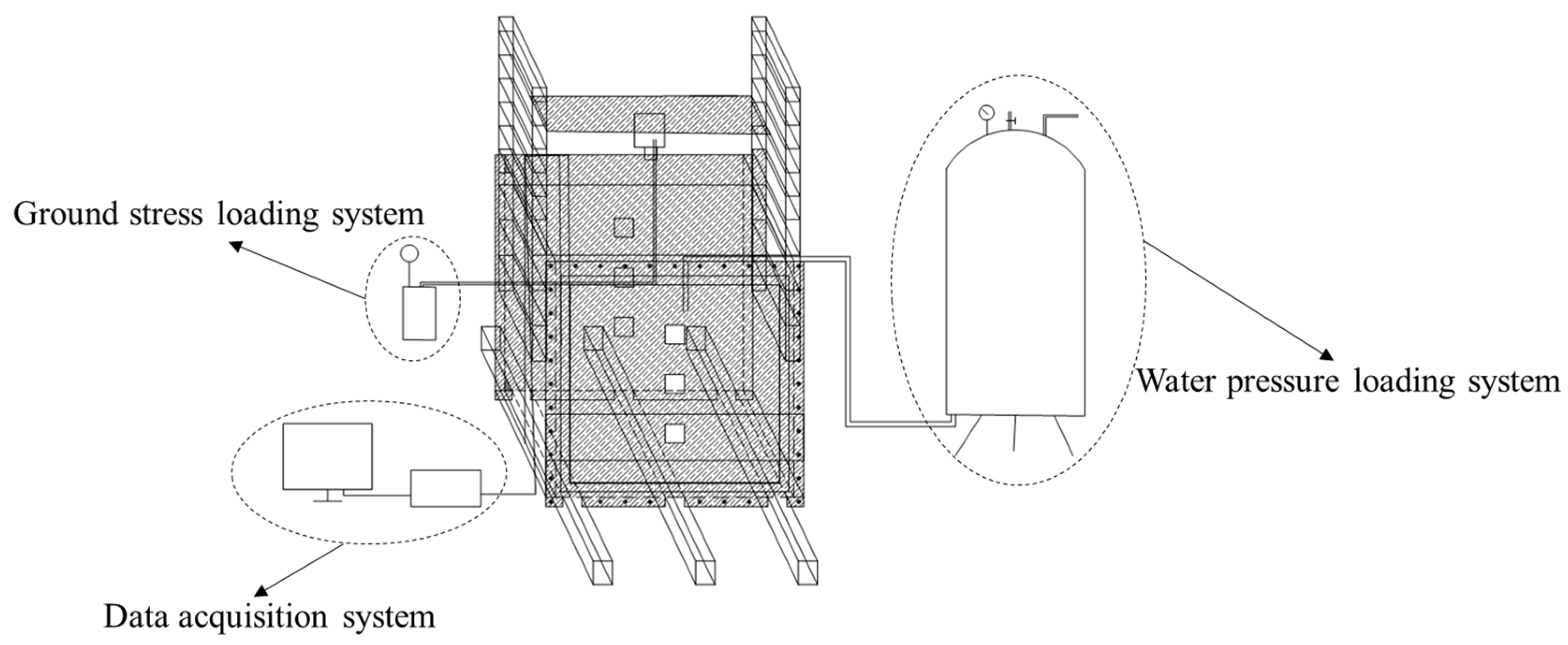



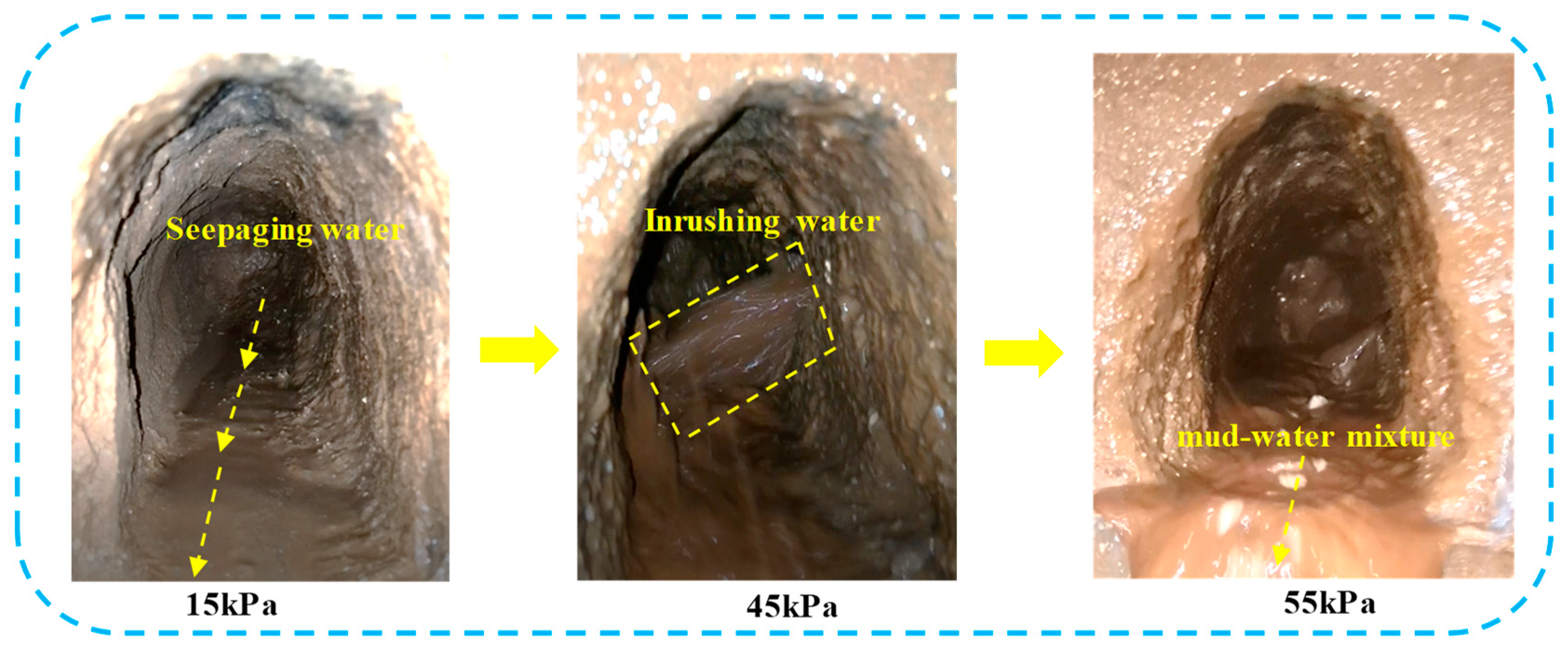
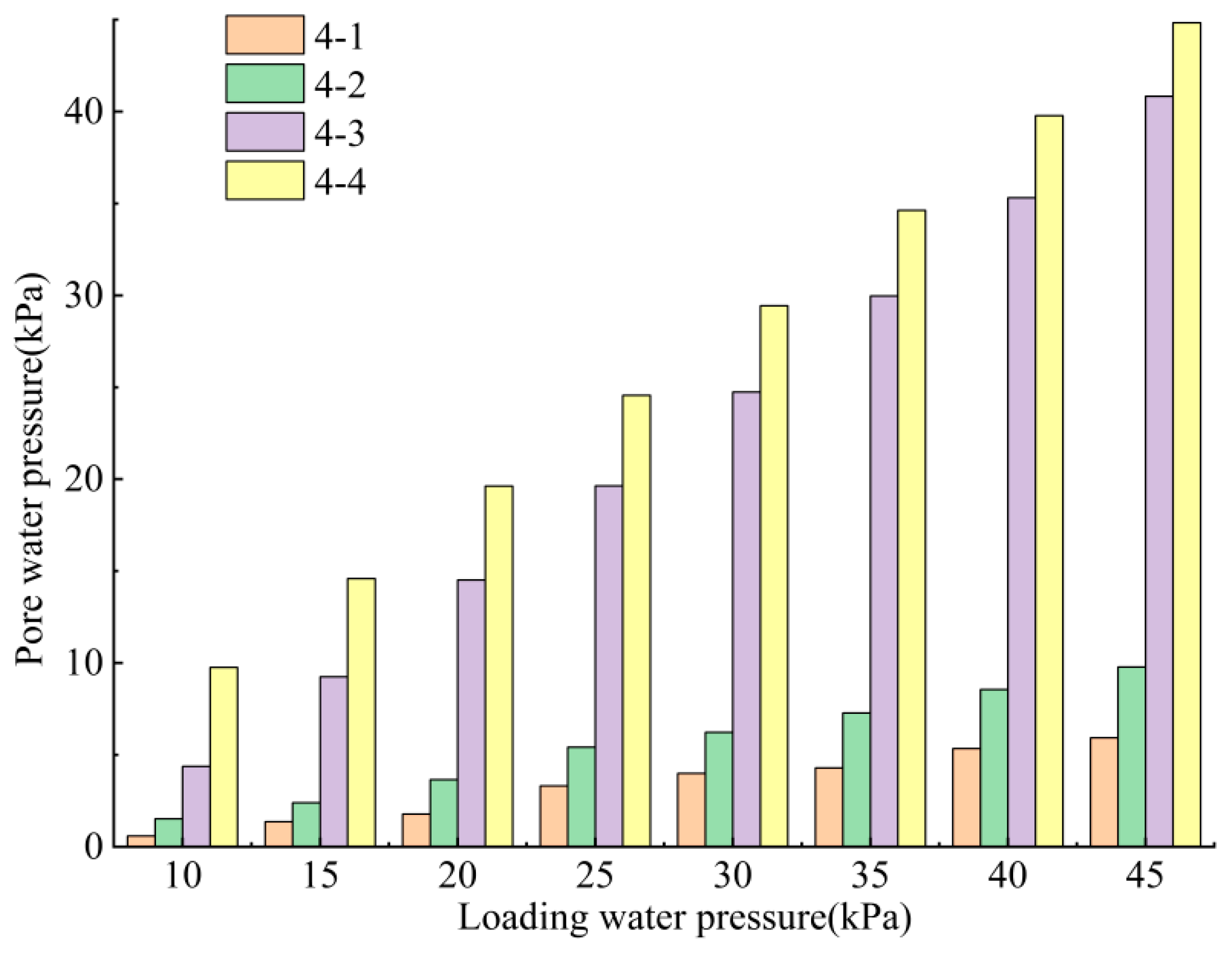


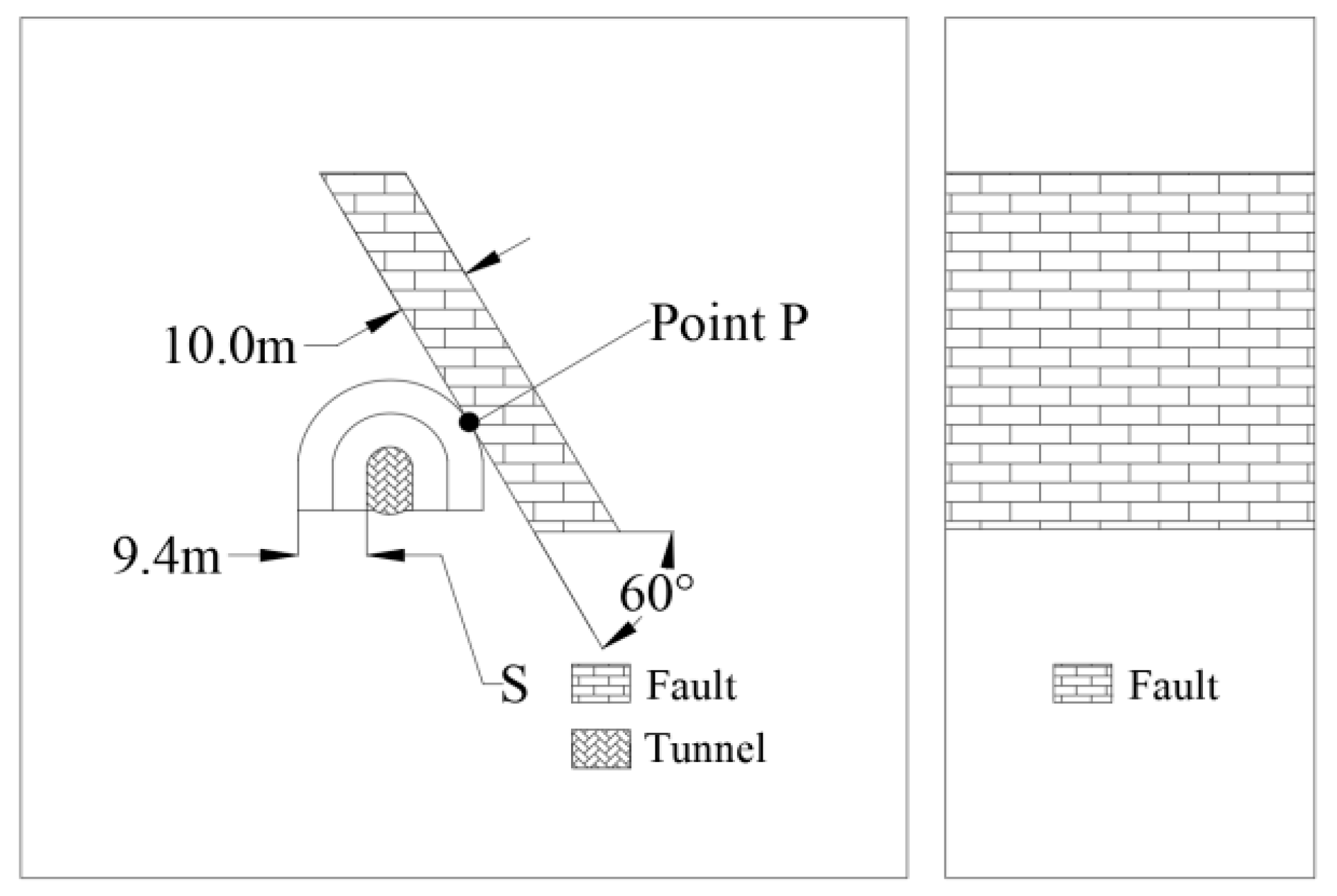


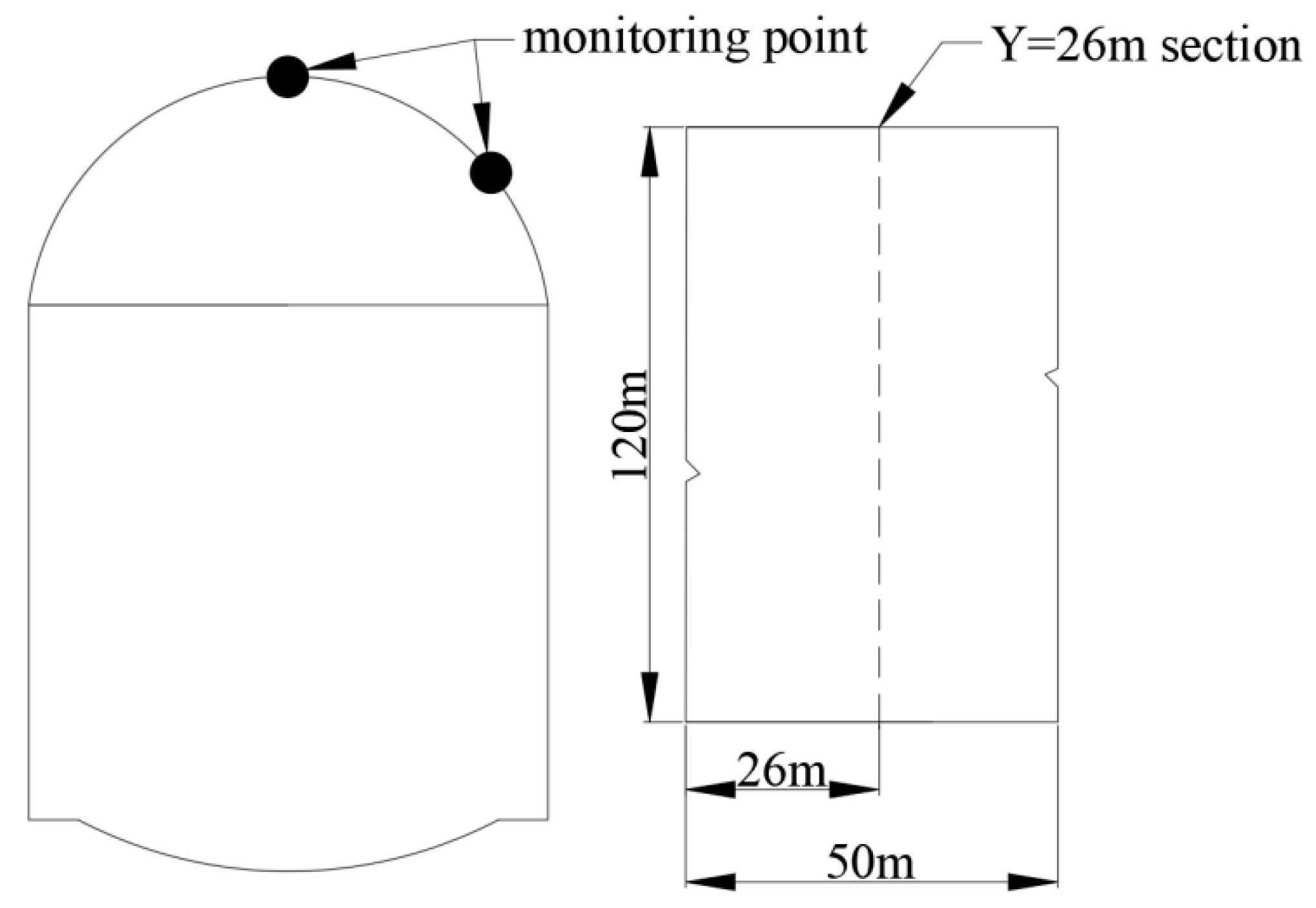
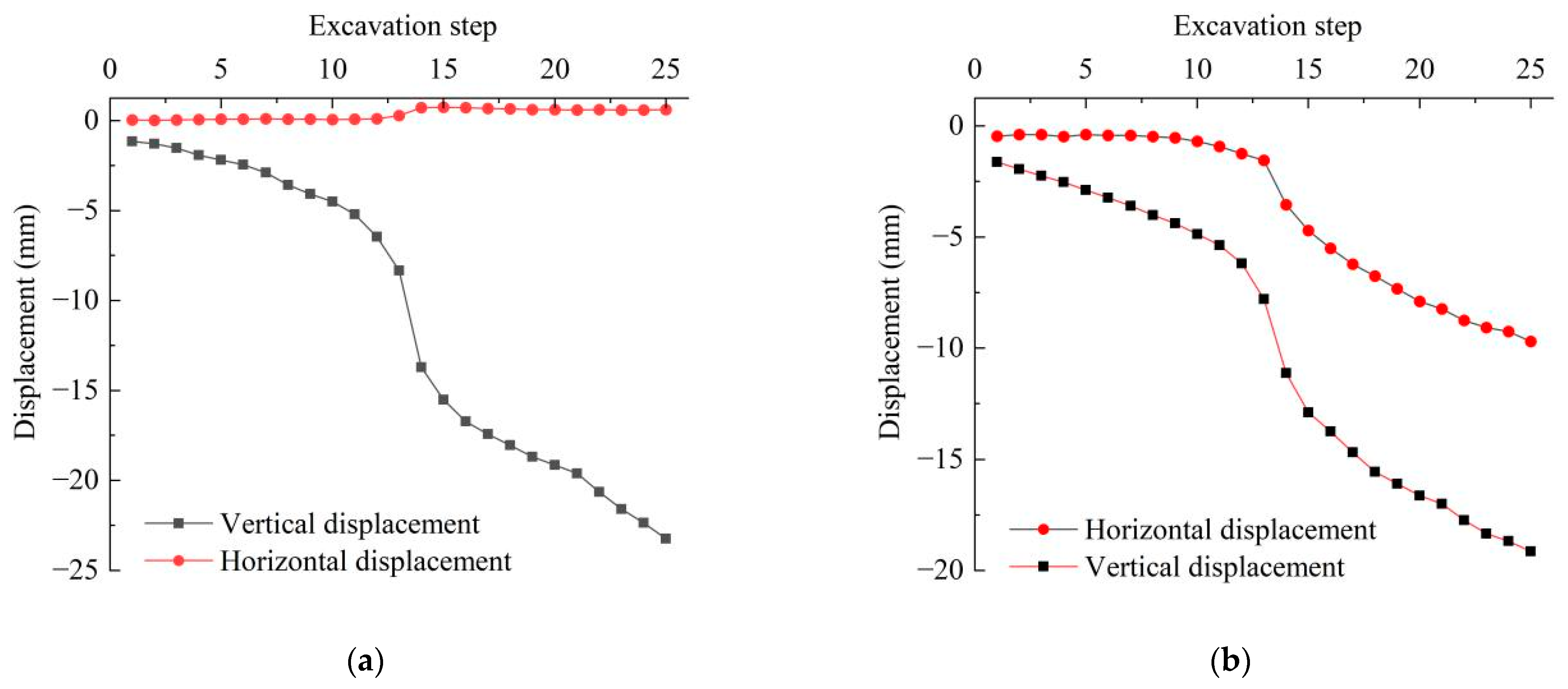
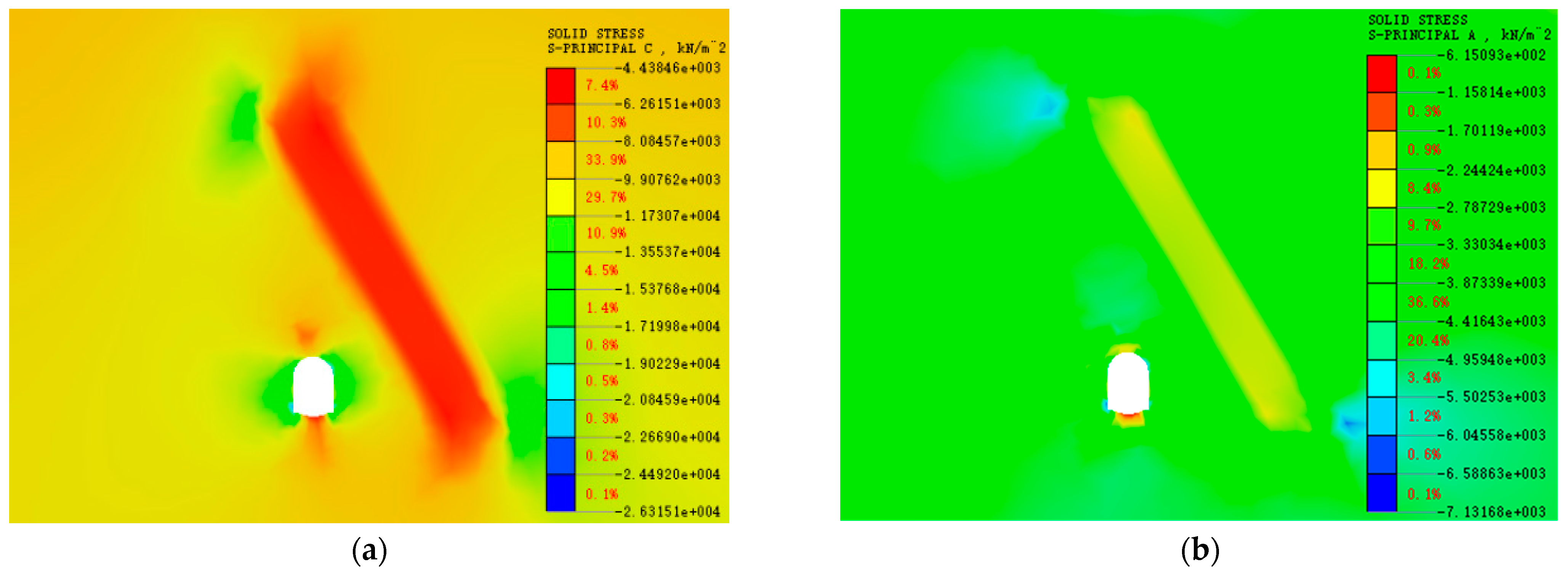


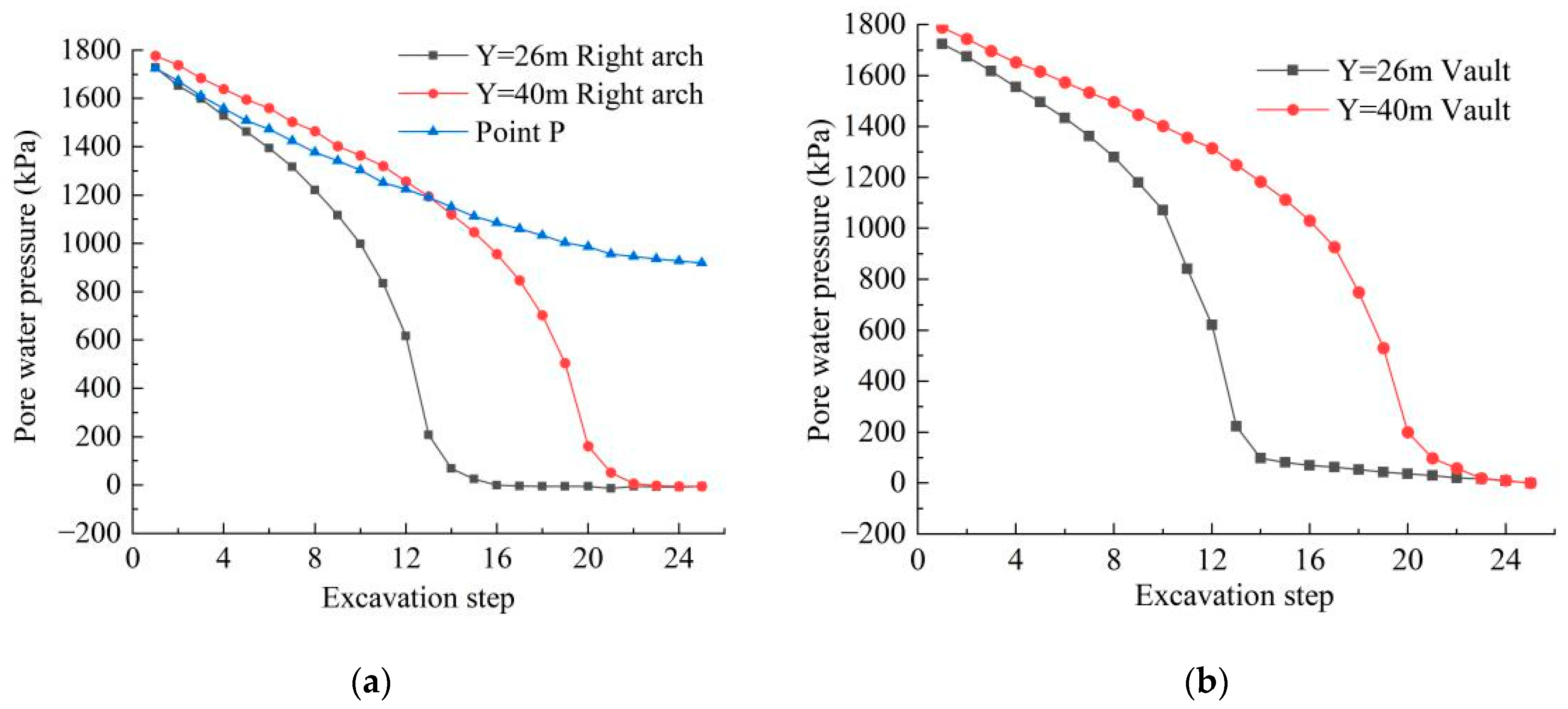
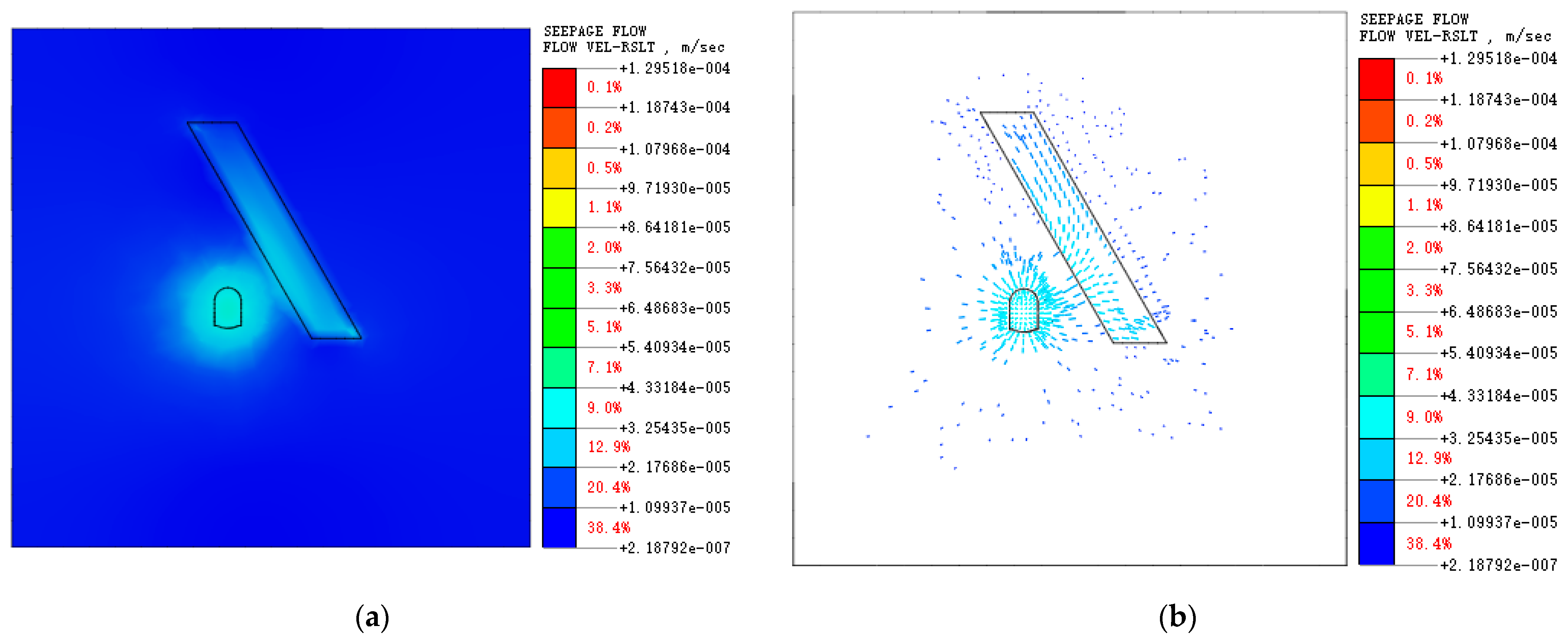

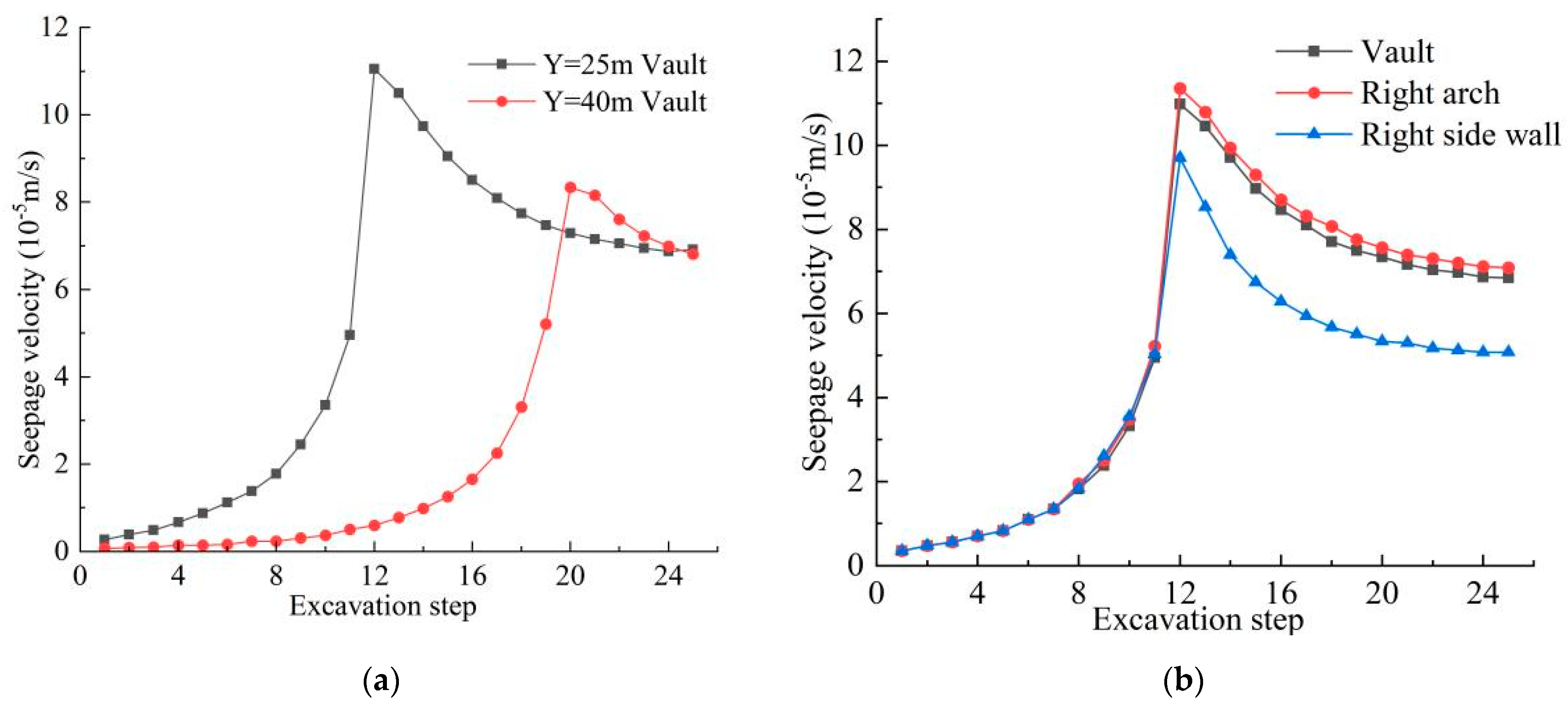
| Materials | Bulk Density (kN/m3) | Compressive Strength (MPa) | Permeability Coefficient (cm/s) |
|---|---|---|---|
| Surrounding rock | 20~23 | 38 | 4.23 × 10−4 |
| Ideal similar materials | 16.67~19.17 | 0.39 | 5.62 × 10−5 |
| Tested similar materials | 17.86 | 0.40 | 5.58 × 10−5 |
| Measuring Points | Loading Water Pressure/kPa | |||||||
|---|---|---|---|---|---|---|---|---|
| 10 | 15 | 20 | 25 | 30 | 35 | 40 | 45 | |
| 4-1 | 0.135 | 0.147 | 0.123 | 0.169 | 0.161 | 0.143 | 0.151 | 0.145 |
| 4-2 | 0.348 | 0.258 | 0.252 | 0.276 | 0.252 | 0.243 | 0.242 | 0.240 |
| 4-3 | 1 | 1 | 1 | 1 | 1 | 1 | 1 | 1 |
| Parameters | Loading Water Pressure/kPa | |||||||
|---|---|---|---|---|---|---|---|---|
| 10 | 15 | 20 | 25 | 30 | 35 | 40 | 45 | |
| a | 9.0340 | 13.3224 | 15.1030 | 11.1279 | 13.0956 | 14.8286 | 14.4717 | 15.0029 |
| b | 0.1762 | 0.2076 | 0.2175 | 0.1933 | 0.2063 | 0.2161 | 0.2142 | 0.2171 |
| R-Square | 0.9994 | 0.9771 | 0.9877 | 0.9691 | 0.9657 | 0.9749 | 0.9693 | 0.9727 |
| Material Type | Bulk Density (kN/m3) | Saturated Bulk Density (kN/m3) | Elastic Modulus (GPa) | Cohesion (MPa) | Internal Friction Angle (°) | Poisson’s Ratio | Permeability Coefficient (cm/s) |
|---|---|---|---|---|---|---|---|
| Class IV surrounding rock | 21.7 | 22.5 | 4.11 | 0.6 | 32.54 | 0.32 | 4.13 × 10−4 |
| Fault | 17 | 18 | 0.9 | 0.05 | 22 | 0.30 | 4.02 × 10−3 |
Disclaimer/Publisher’s Note: The statements, opinions and data contained in all publications are solely those of the individual author(s) and contributor(s) and not of MDPI and/or the editor(s). MDPI and/or the editor(s) disclaim responsibility for any injury to people or property resulting from any ideas, methods, instructions or products referred to in the content. |
© 2024 by the authors. Licensee MDPI, Basel, Switzerland. This article is an open access article distributed under the terms and conditions of the Creative Commons Attribution (CC BY) license (https://creativecommons.org/licenses/by/4.0/).
Share and Cite
Guo, Y.; Li, S.; Mao, S.; Song, Q.; Zheng, L.; Yan, H.; Li, X.; Niu, Y. Study on Catastrophic Evolution Law of Water and Mud Inrush in Water-Rich Fault Fracture Zone of Deep Buried Tunnel. Buildings 2024, 14, 2220. https://doi.org/10.3390/buildings14072220
Guo Y, Li S, Mao S, Song Q, Zheng L, Yan H, Li X, Niu Y. Study on Catastrophic Evolution Law of Water and Mud Inrush in Water-Rich Fault Fracture Zone of Deep Buried Tunnel. Buildings. 2024; 14(7):2220. https://doi.org/10.3390/buildings14072220
Chicago/Turabian StyleGuo, Yanhui, Shunyin Li, Shilin Mao, Qin Song, Lei Zheng, Hang Yan, Xiaoqiang Li, and Yong Niu. 2024. "Study on Catastrophic Evolution Law of Water and Mud Inrush in Water-Rich Fault Fracture Zone of Deep Buried Tunnel" Buildings 14, no. 7: 2220. https://doi.org/10.3390/buildings14072220






